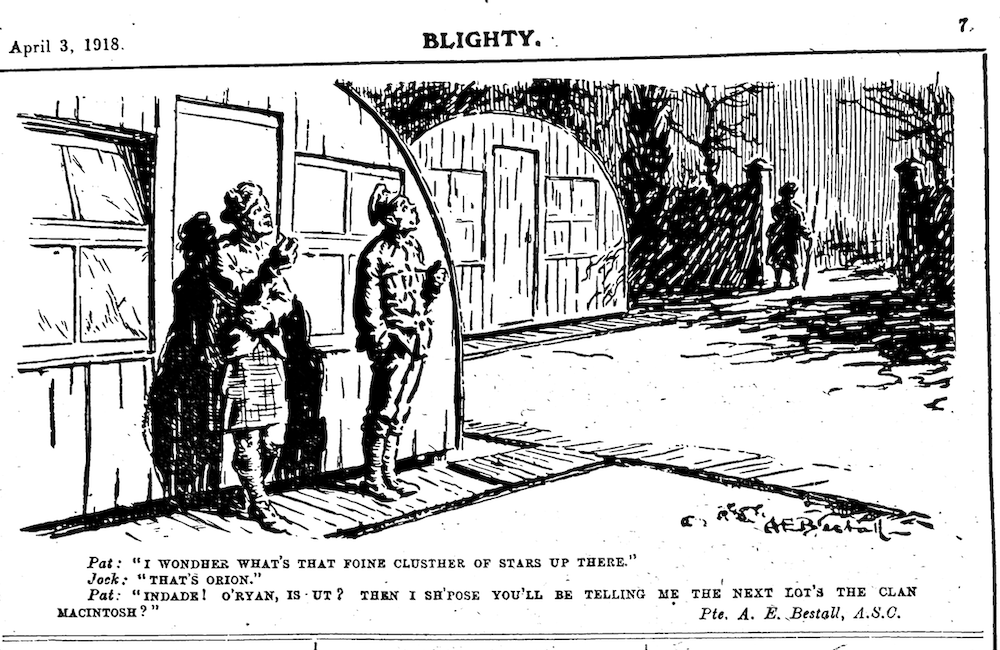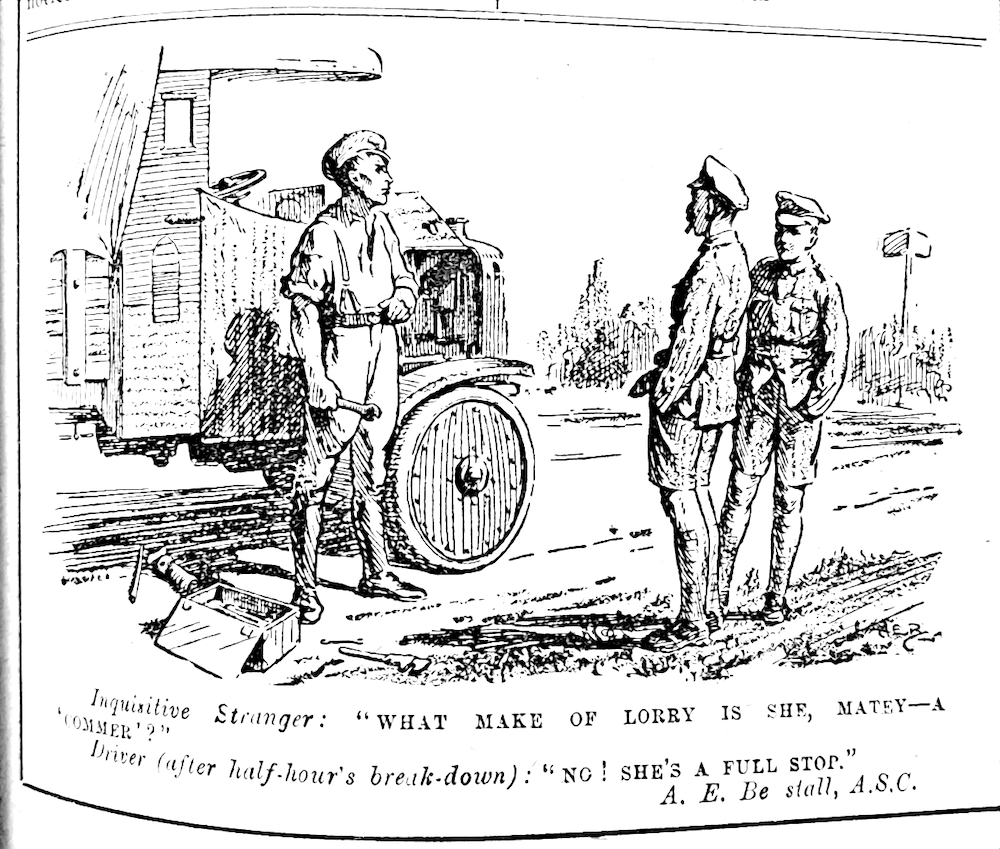Soldier-cartoonist: Private Alfred Edmeades Bestall, Army Service Corps
Private Alfred Edmeades Bestall, Army Service Corps
Service Number: DM2/112832
Born: 14 December 1892, Mandalay, Burma
Died: 15 January 1986, Porthmadog, Wales (Aged 93)
I am the type of person, who when visiting an art gallery, bowls past the information desk, brushes off the tour guide, and boots the audio-headset out of the window. This is because I like to be guided by my eyes. When undertaking the research for my Masters, I had to adapt a very cold, methodical, and calculated approach. This was because one of the things I was most adamant to avoid was any accusation, in the selection of cartoons used in my survey, that I had 'chosen a narrative'. It also had to be this way because of the limited time I had with the archival material.
However, from Blighty, this cartoon really stood out for me, as there is just something about both the composition and the depiction of light and shadow.

I came across several other cartoons in Blighty by Bestall and, from a technical perspective, Figure 2 below is noteworthy and of merit due to its draughtsmanship. For example, the foreshortening of the driver's left arm, the attention to light and shadows, and the curve in the 'Inquisitive Stranger's' back is a textbook example of the line of balance — an imaginary line that runs from the middle of the neck to the ground that establishes the centre of gravity. In my cold and methodologic mindset, all I was thinking at the time was: these were clearly drawn by someone who was technically accomplished and had some very good training. Note the typo in the name at the bottom of the cartoon —not an uncommon occurrence in the magazine, so, once back from the archives, I began a search of variations — Bearstall, Betall, etc. — before realising — and kicking myself — it was of course Alfred Bestall, whose later career would see him illustrate for magazines such as Punch and Tatler, most famously as the long-running illustrator for Rupert the Bear in the Daily Express.

Alfred was born in Mandalay, Burma in 1892 — his father, the Reverent Arthur Bestall, was a Methodist missionary who had established schools and a leper home in Mandalay. For reasons unknown, both Alfred and his younger sister Masie were bought to England in 1897 with Alfred suffering from a spinal injury, along with impeded speech, and his sister suffering from mental impairment. His parents would return to Mandalay, leaving him in the care of a friend of the family, the Reverend W. Ripley Winston, and his sister in the care of his grandparents.1 He would go on to attend Rydal Mount School, Wales, from 1904-1911 where he would win prizes for drawing and the classics. As well as being a school prefect, he was quite the cricket player, with the school magazine saying 'The fielding of Bestall has been one of the features of the term's play'. In June 1911, he took the University of London Matriculation, placing in the second division. 2 He went on to study at the Birmingham Central School (now College) of Art, after being awarded a three-year scholarship from a sketch he submitted entitled 'The Strike'.3 After completing his studies in Birmingham, he attended the London Central School of Art and Crafts in Camden (LCC) in 1915. He spent his free time sending in submissions to the likes of Tatler and the Sphere, and after much rejection, had a cartoon published in the magazine Cartoon, and would later go onto have submissions printed in the Passing Show and the London Opinion.4
He had tried to enlist in the army on the outbreak of war but failed due to his physique. After several more attempts, having been 'troubled by his conscious' — and a passionate plea — he was finally accepted in the Army Service Corp in the summer of 1915.5 The DM2 in his soldier number refers to Mechanical Transport Learners — those who hadn't previously known how to drive a vehicle when signing up — and in the autumn of the same year, he was moved to Grove Park barracks, London, where he learned to drive a B-Type Double-Decker bus. Some 1,000 of these buses had been requisitioned by the War Office, from the London General Omnibus Company, and many were converted into lorries, ambulances, mobile workshops, and even mobile pigeon lofts.6 Alfred himself said that he had formed an affection for the B-Type as it was 'One of the easiest vehicles I have ever driven'.7 In 1916, having completed his training in January, he was sent to France, attached to the 35th Infantry Division — originally a Bantam outfit composed of soldiers who would have otherwise been excluded to due to being under the required 5 feet 3 inches height requirement for the army.8 The Division would see action at the Somme (1916), Passchendaele (1917), Bapaume (1918) and the Final Advance in Flanders (1918).9 He remained a Private throughout, having turned down the opportunity of a promotion to Corporal as 'it would have meant a desk job, preferring the open-air life on the road which he found beneficial to his health'.10 Alfred was demobbed in June of 1919.
He first sent a submission into Blighty in April 1917 (Figure 1), and his biography confirms something I have long suspected: that the staff of Blighty came to an arrangement with certain soldiers who had their cartoons featured in the magazine — including Bestall.11 The 26 September 1917 issue, which carried Figure 2, also contained two other drawings by Bestall for which he was paid a total of £1, 11s, 6d.12
After the war he resumed his studies at LCC, and in 1920 he landed a job illustrating Enid Blyton's children's books, which would mark the start of a career that would span over 50 years.13
In 1985, he was appointed an MBE in the Birthday Honours. One year later, at the aged of 93, he passed away. 14
Further information about Alfred Bestall's life can be found on the Lambiek Comiclopedia
-
Caroline G. Bott, The Life and Works of Alfred Bestall (London: Bloomsbury, 2003), pp.2-4. ↩︎
-
C.G. Bott, Life and Works of Alfred Bestall, pp.10 -11. ↩︎
-
C.G. Bott, Life and Works of Alfred Bestall, p.11. ↩︎
-
C.G. Bott, Life and Works of Alfred Bestall, pp.17-18. ↩︎
-
C.G. Bott, Life and Works of Alfred Bestall, p.20. ↩︎
-
https://www.ltmuseum.co.uk/collections/stories/transport/london-buses-during-first-world-war, retrieved 9 August 2023. ↩︎
-
C.G. Bott, Life and Works of Alfred Bestall, p.21. ↩︎
-
https://www.longlongtrail.co.uk/army/order-of-battle-of-divisions/35th-division/, retrieved 16 September 1916. ↩︎
-
https://www.longlongtrail.co.uk/army/order-of-battle-of-divisions/35th-division/, retrieved 16 September 1916; ↩︎
-
C.G. Bott, Life and Works of Alfred Bestall, p.42. ↩︎
-
C.G. Bott, Life and Works of Alfred Bestall, pp.29-30, 35. ↩︎
-
C.G. Bott, Life and Works of Alfred Bestall, pp.297-298. ↩︎
-
C.G. Bott, Life and Works of Alfred Bestall, pp.43-44. ↩︎
-
C.G. Bott, Life and Works of Alfred Bestall, p.119. ↩︎
Posts in this series
- Soldier-cartoonist: Corporal Harry Cotton, Meteorological Office, 4th Army HQ
- Soldier-cartoonist: Sapper Charles Albert Kennett, Royal Engineers
- Soldier-cartoonist: Private Louis Ollier, 8th Cheshire Regiment
- Soldier-cartoonist: Private Alfred Edmeades Bestall, Army Service Corps
- Blighty Mystery File No.1
- Soldier-cartoonist: Corporal Bertie Inward, 2/19th London Regiment
- Soldier-cartoonist: Private Richard Collins, 12th Battalion East Surrey
- Solider-cartoonist: Corporal Gontran De Tournoüer, 11th Field Artillery Brigade, Australian Imperial Force.
- Soldier-cartoonist: Lance Corporal Gilbert Tom Webster 26th Royal Fusiliers
- Soldier-cartoonist: Private Charles "Chas" William Holt, 16th Sherwood Foresters [Unconfirmed]
- Soldier-cartoonist: Corporal Robert Birrell, 17th Highland Light Infantry
- The ‘Budding Bairnsfathers’ : First World War Soldier-cartoonists Published in Blighty